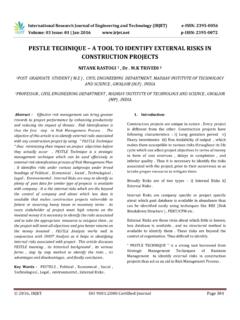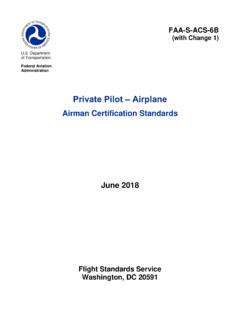Transcription of Example Using the ACS for Scenario-Based Evaluation
1 Example Using the ACS for Scenario-Based Evaluation You have scheduled an applicant for a Private Pilot ASEL practical test. During your initial contact with the applicant (or recommending instructor), you request a copy of the applicant s airman knowledge test report (AKTR). Upon reviewing the AKTR, you note that it lists the following Learning Statement Code: PLT377 (Recall Regulations airworthiness certificates, requirements, responsibilities). For each Task, the ACS requires you to test at least one Knowledge element, at least one Risk Management element, and all Skill elements. As with the PTS, however, the ACS gives you the discretion to test additional Task elements as necessary. Using the ACS to develop your Plan of Action (POA) for the practical test, you review the Airworthiness Requirements Task (see below). Based on the information in the AKTR, you note that you will definitely need to retest the applicant on Knowledge Task element This selection satisfies the minimum requirement.
2 Task B. Airworthiness Requirements Reference 14 CFR parts 39, 43, 91; FAA-H-8083-2, FAA-H-8083-25 Objective To determine that the applicant exhibits satisfactory knowledge, skills and risk management associated with airworthiness requirements, including aircraft certificates. Knowledge The applicant demonstrates understanding of: 1. General airworthiness requirements and compliance for airplanes. a. Certificate location and expiration dates b. Required inspections. c. Inspection requirements 2. Individuals who can perform maintenance on the aircraft, including A&P and IA roles in aircraft maintenance and inspections. 3. Pilot-performed preventive maintenance. 4. Equipment requirements for day and night flight for Example : flying with inoperative equipment (approved Minimum Equipment List (MEL), Kinds of Operation Equipment List (KOEL), VFR and placards. 5. Proving airworthiness (specifics of the aircraft compliance with Airworthiness Directives (AD) or applicability of Safety Bulletins (SB)).)
3 6. Obtaining a special flight permit. 7. Experimental aircraft airworthiness. 8. Equipment malfunctions. 1 | Page In accordance with the ACS requirement to test at least one Risk Management element in each Task, you look over the three Risk Management elements for this Task and you select , inoperative equipment. Risk Management The applicant demonstrates the ability to identify, assess and mitigate risks , encompassing: 1. Inoperative equipment. 2. Equipment failure during flight. 3. Discrepancy records or placards. Next, you review and note the requirement to test all Skill elements. Skills The applicant demonstrates the ability to: 1. Locate aircraft airworthiness information. 2. Determine the aircraft is airworthy in a scenario given by the evaluator. 3. Explain conditions where flight can be made with inoperative equipment. 4. Explain requirements for obtaining and flying with a Special Flight Permit.
4 5. Locate and explain operating limitations, placards, instrument markings, POH/AFM, weight and balance data, and equipment list. In your initial contact with the applicant, you provide an overall scenario for the practical test and ask the applicant to plan accordingly. The scenario for this test: You are taking your mother, father and grandmother to a wedding in Palm Springs, CA. The flight begins in the afternoon, and you will be returning that night. Your mother weighs 145 pounds, your father weighs 195 pounds and your grandmother weighs 115 pounds. Since it is a day trip, there is no luggage. But your parents are bringing the wedding gift, which is a 50-pound set of dishes. 2 | Page On the day of the test, you administer the pre-test briefing and determine that the applicant is eligible to take the practical test. Once the test has begun, you start with Area of Operation I, Task A, Pilot Qualifications.
5 To the greatest possible extent, you frame your questions on the Knowledge and Risk Management elements you have selected for each Task in accordance with the overall scenario of a flight to attend the wedding. The Evaluation of each element is complete when the applicant demonstrates a good understanding of airman documents and identification required when exercising private pilot privileges. You use follow-up questions as necessary and, as stated already, you have the discretion to evaluate additional Task elements as needed. As you move into Task B, you add to the overall scenario as follows: During your preflight, an FAA aviation safety inspector (ASI) introduces himself and says he wants to conduct a ramp inspection. After checking your pilot and medical certificates, the ASI asks how you determined that the airplane was in an airworthy condition. This scenario should prompt the applicant to explain aircraft documents required to be on board the aircraft, and possibly the status sheet, demonstrating compliance with required inspections.
6 This explanation allows you to evaluate the first Skills element, and you ask additional questions to assess the applicant s grasp of the others. You then use a trigger event to build on the scenario and continue your Evaluation : The FAA inspector is satisfied. He shakes your hand, and moves to the next airplane. You continue your preflight. You turn the master switch on, turn on all the external lights, and perform a walk-around. You notice that the landing light is inoperative. Now what? The trigger event allows you to evaluate Knowledge Task element , because it requires the applicant to explain whether it is legal to take the flight with a landing light inoperative, and how to properly defer this item. The applicant may refer to 14 CFR part 91, , and the discussion must cover equipment requirements for day/night VFR/IFR flight, along with the proper deferral of inoperative equipment and placard installation.
7 The applicant should explain that since the flight is not for compensation, he may legally defer it. This point leads to Evaluation of the Risk Management element you selected earlier, Perception of risk depends on many factors, and it is obviously not the same for every pilot. What you are looking for is the applicant s analysis of how the selected Risk Management element affects his or her own situation. In this instance, you might look for the applicant to explain that the risk of conducting a night flight with family on board is higher for a newly certificated pilot. The applicant could mitigate this risk by arranging to have the landing light replaced before departure, or (if repair facilities are available) having it replaced at the destination airport while the family is attending the wedding. Other responses may also be 3 | Page acceptable again, the point is for the applicant to demonstrate that he or she has identified, evaluated, and mitigated the risk in the context of the proposed operation.
8 Using your Plan of Action and the scenario you developed, you have now covered the required ACS Knowledge, Risk Management, and Skill elements for this Task. You continue to use the wedding trip scenario as you work through the remaining ground and flight portions of the practical test. The wedding trip scenario clearly lends itself to testing Tasks in some Areas of Operation ( , Navigation, Landings). As an Example of how to extend it to other Areas of Operation, such as Performance Maneuvers, you might use another trigger event: As you fly toward your destination, you offer to make a slight diversion from your route so your parents can see their house from the air. Your mother is excited to see her house from the air, and she asks if you can descend and circle so she can take pictures. You can use this trigger to evaluate the applicant on the Ground Reference Maneuvers Task. To evaluate Tasks in the Emergency Operations AOO, use a trigger event such as an electrical or other system malfunction.
9 If it is not possible or practical to incorporate every Task into the scenario, you may suspend the scenario to perform those maneuvers and then continue. For more information, refer to Volume 5, Chapter 2, Section 1, Paragraph 5-219 item C. 4 | Page ACS Plan of Action Scenario Triggers EVENT Job Interview Family Emergency Family Illness/Surgery Birth-Child/Grandchild Medical Appointment Wedding Funeral Graduation Family Reunion Concert Vacation Catch Airline Flight Return To College Sporting Event Job Presentation Birthday Party Baptism/Christening Camping Trip Beach Week-End Lunch With Boss Dinner With Boss Engagement Party Surprise Party Christmas Dinner Thanksgiving Dinners Skiing Week-End Rock Climbing Event River Rafting Event Hunting Trip Fishing Trip Fly-In With Friends Aviation Safety Presentation Aviation Conference Flight to Oshkosh for Air Venture Meeting In-laws for First Time College Scholarship Meeting Returning to College Returning for Military Duty PASSENGER Shows up Late Recently Scuba Diving Brings Extra Luggage Brings Pet Arrives Drinking/ Drunk Lied about Weight-(Exceeds Weight & Balance Limits)
10 Gets Airsick/Throws Up Gets Hypoxic Hyperventilates Ear Block/Sinus Block Afraid Hysterical Needs Restroom Uses Cell Phone in Flight Wants to Land & Get Off the A/C Immediately Wants to Fly Airplane Crying Baby Aboard PILOT/AIRCRAFT FAA Ramp Check A/C Registration Expired Weight and Balance Docs Missing Radio Station License Missing Pilot Medical Expired Photo ID Expired Pilot Certificate at Home A/C Documents-Missing VOR check out of date Autopilot operating manual missing not signed off at inspection Pilot has not flown in four months Pilot has not flown in three years Pilot has not carried passengers in three months Pilot left his logbook at home Aircraft is Out of Annual Before Return From Cross Country Pilot is Blinded by Passenger Cell Phone Picture Flash on Landing WEATHER Turbulence Strong Head Winds Aloft Strong Surface Wind/Crosswind Thunderstorms Lightning Hail Dust Storms Snow Fog Low Visibility Lowering Ceiling Icing Conditions Freezing Rain Weather in Class D goes to 2 SM Operating Above 10.
















